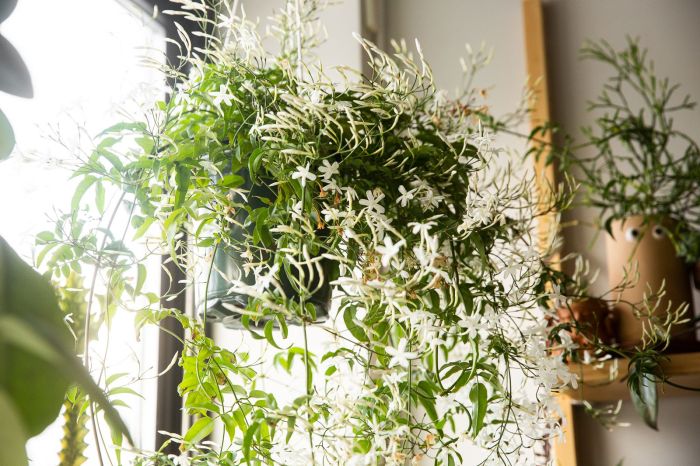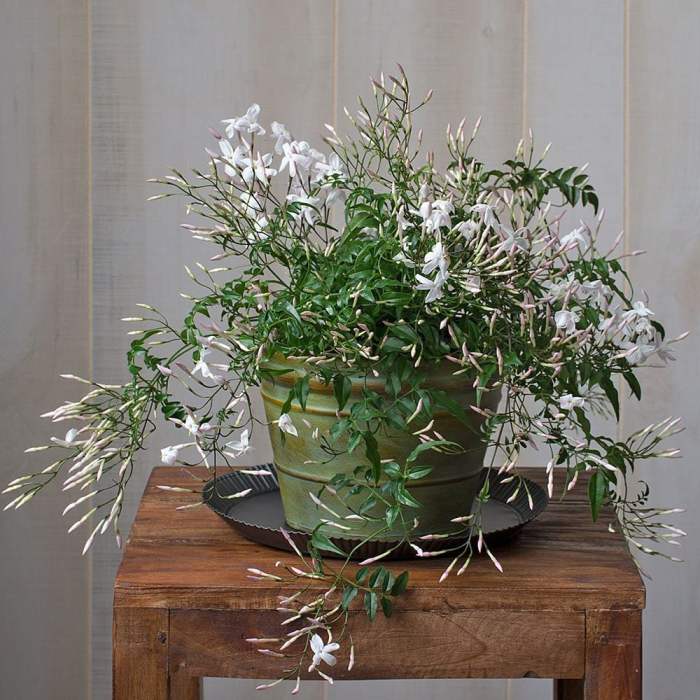Hanging jasmine plant indoor – Hanging jasmine plants indoors offer a touch of elegance and fragrance to any living space. These versatile plants thrive with proper care and attention, rewarding you with a cascade of blooms and a sweet aroma. This guide will provide you with everything you need to know to successfully cultivate hanging jasmine plants indoors, from optimal lighting conditions to pruning and maintenance techniques.
Whether you’re a seasoned plant enthusiast or just starting your indoor gardening journey, this comprehensive guide will help you create a thriving indoor oasis with the beauty and fragrance of hanging jasmine plants.
Light Requirements
Indoor hanging jasmine plants thrive under bright, indirect light. They prefer locations near east- or west-facing windows, where they receive ample natural light without direct exposure to the sun’s intense rays.
Hanging jasmine plants indoors can bring a touch of elegance and fragrance to any room. For those looking for other real hanging plants, there are numerous options available. Hanging plants indoor real offers a wide selection of real hanging plants, including trailing vines, ferns, and succulents, that can add life and color to any indoor space.
With proper care, hanging jasmine plants and other real hanging plants can thrive indoors, providing beauty and purification to the air.
Insufficient light can hinder growth, leading to weak stems, sparse foliage, and reduced flowering. Conversely, excessive light can scorch the leaves, causing yellowing or browning.
Light Intensity
- Optimal light intensity for hanging jasmine plants ranges from 100 to 200 foot-candles.
- To measure light intensity, use a light meter or refer to online resources that provide estimates based on window orientation and time of day.
Watering and Humidity
Maintaining optimal hydration and humidity levels is crucial for the well-being of hanging jasmine plants indoors. Proper watering techniques and adequate humidity promote healthy growth and prevent common issues like wilting or yellowing leaves.
Watering Techniques
- Water the plant thoroughly, allowing the excess water to drain from the pot’s drainage holes.
- Avoid overwatering, as it can lead to root rot and other problems.
- Allow the top inch of soil to dry out before watering again.
- Use lukewarm water to water the plant.
Humidity Levels
Hanging jasmine plants prefer high humidity levels, which can be challenging to maintain indoors. Some methods to increase humidity include:
- Misting the plant regularly with a spray bottle filled with water.
- Placing the plant on a tray filled with pebbles and water, creating a humid microclimate.
- Using a humidifier in the room where the plant is located.
Fertilizing and Soil

Hanging jasmine plants require proper fertilization and well-draining soil to thrive indoors. Regular feeding and optimal soil conditions ensure healthy growth and abundant blooms.
Fertilizer, Hanging jasmine plant indoor
Fertilize hanging jasmine plants every two to three weeks during the growing season (spring and summer) with a balanced liquid fertilizer diluted to half strength. Choose a fertilizer with an NPK ratio of 10-10-10 or 12-12-12. Avoid over-fertilizing, as this can damage the plant.
Soil
Hanging jasmine plants prefer well-draining, slightly acidic soil with a pH of 5.5 to 6.5. A mixture of potting soil, peat moss, and perlite provides the ideal balance of drainage and moisture retention. Ensure the pot has drainage holes to prevent waterlogging.
Pruning and Maintenance: Hanging Jasmine Plant Indoor
Proper pruning and maintenance are crucial for healthy and vigorous hanging jasmine plants. Pruning techniques enhance growth, encourage flowering, and maintain a pleasing appearance.
Pruning
Regular pruning stimulates new growth and promotes a bushier, more compact plant. To prune, use sharp, clean shears to remove any dead, diseased, or damaged stems. Additionally, cut back overgrown stems to control the plant’s size and shape.
Cleaning and Pest Control
Regularly cleaning the leaves of hanging jasmine plants removes dust and debris, allowing them to absorb sunlight and photosynthesize efficiently. Inspect the plant for pests such as aphids, mealybugs, or spider mites. If pests are detected, treat the plant with an appropriate insecticide or neem oil solution.
Hanging jasmine plants indoors adds a touch of fragrance and beauty to any room. If you’re looking for a way to take your indoor gardening to the next level, consider using an indoor herb wall planter self watering . These planters are designed to provide your plants with the perfect amount of water and nutrients, making them ideal for busy plant parents.
With an indoor herb wall planter self watering, you can enjoy the benefits of hanging jasmine plants indoors without having to worry about overwatering or under watering.
Varieties and Uses

Hanging jasmine plants, with their cascading stems and fragrant blooms, offer a touch of elegance to any indoor space. These versatile plants come in various varieties, each with unique characteristics and growth habits. Understanding these variations helps in selecting the ideal plant for your decor and care preferences.
Hanging jasmine plants indoors can add a touch of fragrance and beauty to any room. To ensure your jasmine plant thrives, consider using indoor window plant hangers . These hangers provide ample support and allow for proper drainage, promoting healthy growth for your hanging jasmine plant.
The table below provides an overview of popular hanging jasmine varieties:
| Variety | Characteristics | Growth Habit |
|---|---|---|
| Trachelospermum jasminoides (Star Jasmine) | Glossy evergreen leaves, fragrant white flowers | Vining, can reach up to 20 feet in length |
| Jasminum officinale (Common Jasmine) | Deciduous, with aromatic white or yellow flowers | Trailing, grows up to 10 feet long |
| Jasminum sambac (Arabian Jasmine) | Evergreen, with large, fragrant white flowers | Bushy, can reach up to 6 feet in height |
| Jasminum polyanthum (Pink Jasmine) | Evergreen, with clusters of pink or white flowers | Trailing, can reach up to 15 feet in length |
Hanging jasmine plants can be incorporated into indoor decor in creative ways. Suspend them from the ceiling for a dramatic display, or place them on a high shelf or windowsill to let their vines cascade down. Use them as a living curtain to divide a room or create a cozy nook.
Their fragrant blooms and lush foliage bring a touch of nature and tranquility to any space.
Final Conclusion

With proper care and attention, hanging jasmine plants can bring years of beauty and fragrance to your indoor living space. By following the tips and techniques Artikeld in this guide, you can create a thriving indoor garden that will delight your senses and enhance your home décor.
Question Bank
How much light do hanging jasmine plants need?
Hanging jasmine plants prefer bright, indirect light. Avoid placing them in direct sunlight, as this can scorch the leaves.
How often should I water hanging jasmine plants?
Water hanging jasmine plants when the top inch of soil feels dry to the touch. Avoid overwatering, as this can lead to root rot.
What type of fertilizer should I use for hanging jasmine plants?
Use a balanced, water-soluble fertilizer diluted to half strength once a month during the growing season.